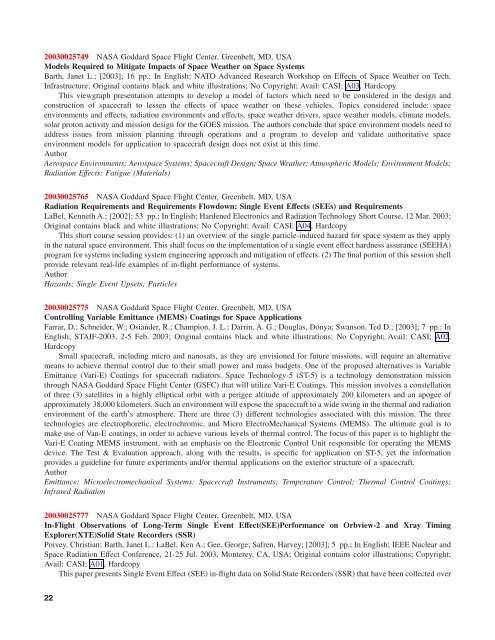Create successful ePaper yourself
Turn your PDF publications into a flip-book with our unique Google optimized e-Paper software.
20030025749 NASA Goddard Space Flight Center, Greenbelt, MD, USA<br />
Models Required to Mitigate Impacts of Space Weather on Space Systems<br />
Barth, Janet L.; [2003]; 16 pp.; In English; NATO Advanced Research Workshop on Effects of Space Weather on Tech.<br />
Infrastructure; Original contains black and white illustrations; No Copyright; Avail: CASI; A03, Hardcopy<br />
This viewgraph presentation attempts to develop a model of factors which need to be considered in the design and<br />
construction of spacecraft to lessen the effects of space weather on these vehicles. Topics considered include: space<br />
environments and effects, radiation environments and effects, space weather drivers, space weather models, climate models,<br />
solar proton activity and mission design for the GOES mission. The authors conclude that space environment models need to<br />
address issues from mission planning through operations and a program to develop and validate authoritative space<br />
environment models for application to spacecraft design does not exist at this time.<br />
Author<br />
Aerospace Environments; Aerospace Systems; Spacecraft Design; Space Weather; Atmospheric Models; Environment Models;<br />
Radiation Effects; Fatigue (Materials)<br />
20030025765 NASA Goddard Space Flight Center, Greenbelt, MD, USA<br />
Radiation Requirements and Requirements Flowdown: Single Event Effects (SEEs) and Requirements<br />
LaBel, Kenneth A.; [2002]; 53 pp.; In English; Hardened Electronics and Radiation Technology Short Course, 12 Mar. 2003;<br />
Original contains black and white illustrations; No Copyright; Avail: CASI; A04, Hardcopy<br />
This short course session provides: (1) an overview of the single particle-induced hazard for space system as they apply<br />
in the natural space environment. This shall focus on the implementation of a single event effect hardness assurance (SEEHA)<br />
program for systems including system engineering approach and mitigation of effects. (2) The final portion of this session shell<br />
provide relevant real-life examples of in-flight performance of systems.<br />
Author<br />
Hazards; Single Event Upsets; Particles<br />
20030025775 NASA Goddard Space Flight Center, Greenbelt, MD, USA<br />
Controlling Variable Emittance (MEMS) Coatings for Space Applications<br />
Farrar, D.; Schneider, W.; Osiander, R.; Champion, J. L.; Darrin, A. G.; Douglas, Donya; Swanson, Ted D.; [2003]; 7 pp.; In<br />
English; STAIF-2003, 2-5 Feb. 2003; Original contains black and white illustrations; No Copyright; Avail: CASI; A02,<br />
Hardcopy<br />
Small spacecraft, including micro and nanosats, as they are envisioned for future missions, will require an alternative<br />
means to achieve thermal control due to their small power and mass budgets. One of the proposed alternatives is Variable<br />
Emittance (Vari-E) Coatings for spacecraft radiators. Space Technology-5 (ST-5) is a technology demonstration mission<br />
through NASA Goddard Space Flight Center (GSFC) that will utilize Vari-E Coatings. This mission involves a constellation<br />
of three (3) satellites in a highly elliptical orbit with a perigee altitude of approximately 200 kilometers and an apogee of<br />
approximately 38,000 kilometers. Such an environment will expose the spacecraft to a wide swing in the thermal and radiation<br />
environment of the earth’s atmosphere. There are three (3) different technologies associated with this mission. The three<br />
technologies are electrophoretic, electrochromic, and Micro ElectroMechanical Systems (MEMS). The ultimate goal is to<br />
make use of Van-E coatings, in order to achieve various levels of thermal control. The focus of this paper is to highlight the<br />
Vari-E Coating MEMS instrument, with an emphasis on the Electronic Control Unit responsible for operating the MEMS<br />
device. The Test & Evaluation approach, along with the results, is specific for application on ST-5, yet the information<br />
provides a guideline for future experiments and/or thermal applications on the exterior structure of a spacecraft.<br />
Author<br />
Emittance; Microelectromechanical Systems; Spacecraft Instruments; Temperature Control; Thermal Control Coatings;<br />
Infrared Radiation<br />
20030025777 NASA Goddard Space Flight Center, Greenbelt, MD, USA<br />
In-Flight Observations of Long-Term Single Event Effect(SEE)Performance on Orbview-2 and Xray Timing<br />
Explorer(XTE)Solid State Recorders (SSR)<br />
Poivey, Christian; Barth, Janet L.; LaBel, Ken A.; Gee, George; Safren, Harvey; [2003]; 5 pp.; In English; IEEE Nuclear and<br />
Space Radiation Effect Conference, 21-25 Jul. 2003, Monterey, CA, USA; Original contains color illustrations; Copyright;<br />
Avail: CASI; A01, Hardcopy<br />
This paper presents Single Event Effect (SEE) in-flight data on Solid State Recorders (SSR) that have been collected over<br />
22
















